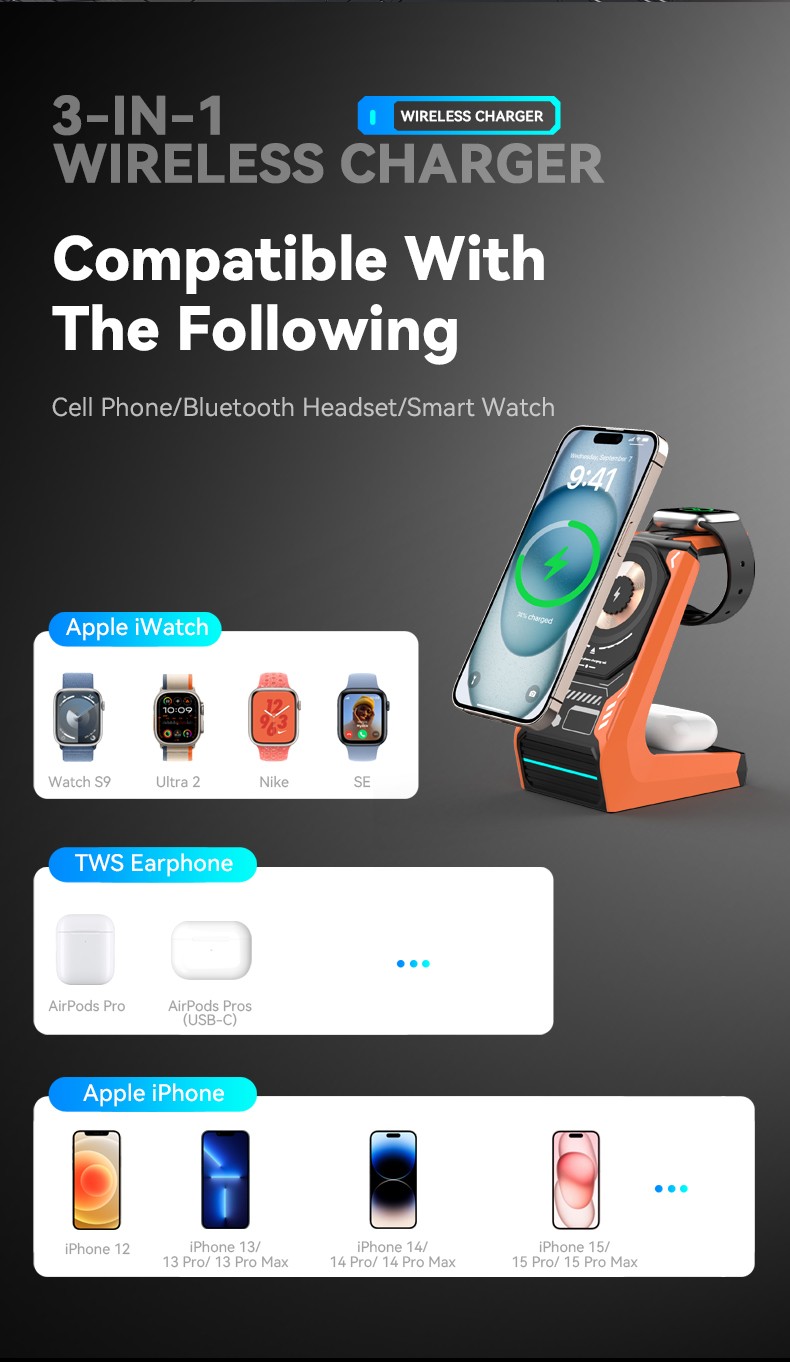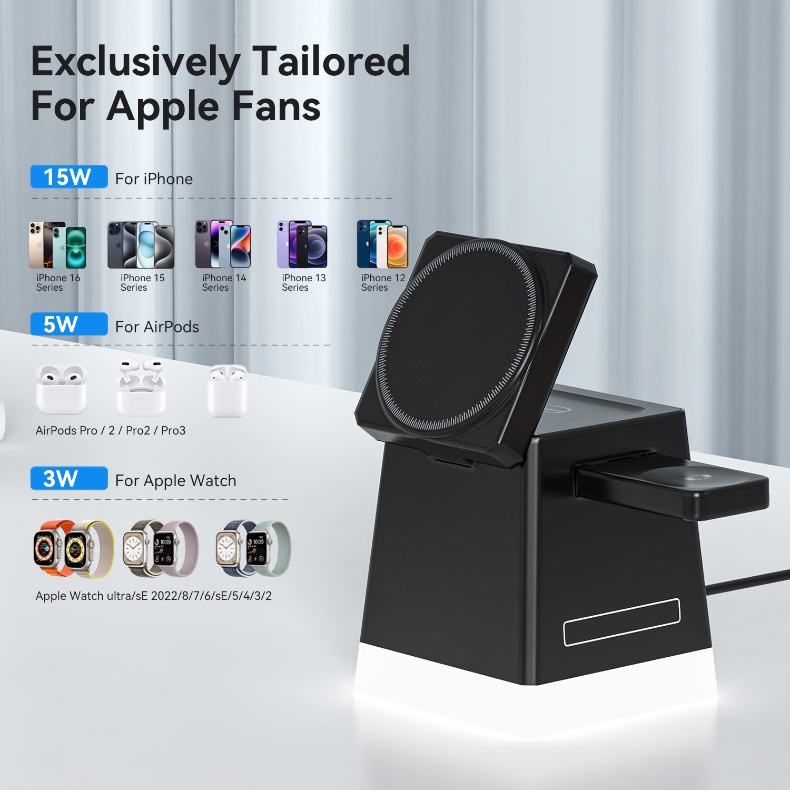In today’s connected lifestyle, most users own more than one smart device — a smartphone, TWS (True Wireless Stereo) earphones, and a smartwatch are now essential daily companions. This has naturally led to a common question: Can wireless chargers work for multiple devices at once?
The short answer is yes, many modern wireless chargers are specifically designed to charge multiple devices simultaneously. However, whether a wireless charger can do this efficiently and safely depends on its design, power output, charging protocol, and device compatibility. Let’s explore how multi-device wireless charging works, what technology powers it, and what you should look for to ensure reliable, efficient performance.

1. How Multi-Device Wireless Charging Works
Wireless charging relies on the principle of electromagnetic induction, standardized by the Qi (pronounced “chee”) wireless charging standard. When electricity passes through a coil in the charger, it creates a magnetic field. A receiver coil inside the smartphone or other device captures this energy and converts it back into electrical power to charge the battery.
A single-device wireless charger contains one primary charging coil. In contrast, a multi-device wireless charger — such as a two-in-one or three-in-one wireless charging stand — integrates multiple coils or independent charging modules. Each coil operates separately, allowing the charger to power more than one device at the same time without interference.
Advanced models also incorporate intelligent charging chips that identify connected devices and distribute power intelligently, ensuring safe and efficient simultaneous charging.
2. Types of Multi-Device Wireless Chargers
Multi-device wireless chargers are available in several configurations depending on user needs and the types of devices being charged:
Two-in-One Chargers – Designed primarily for smartphones and TWS earphones. These models include one high-power coil (typically 10W–15W) for the phone and a secondary 3W–5W coil for the earphone case.
Three-in-One Chargers – These are among the most popular options for users with multiple smart accessories. A three-in-one charger typically powers a smartphone, smartwatch, and wireless earbuds simultaneously. Each charging area is optimized for a specific device’s requirements — for example, 15W for a phone, 5W for earbuds, and 2.5W–3W for a smartwatch.
Foldable or Stand-Type Chargers – These compact, travel-friendly chargers combine several charging surfaces into one foldable design or multi-angle desktop stand. They’re especially popular for users who want a single charging station for both home and travel.
Free-Position or Multi-Coil Pads – Advanced models use overlapping coil arrays that let users place devices anywhere on the pad without precise alignment. Intelligent coil detection ensures only the coils beneath the device activate, optimizing efficiency and reducing heat.

3. Power Management: How Charging Is Shared
Each device connected to a multi-device charger requires a specific amount of power. For example:
- Smartphones: 10W–15W
- Earbuds or charging cases: 3W–5W
- Smartwatches: 2–3W

A three-in-one wireless charger typically needs a minimum of 25–30W total output to power all three devices effectively.
However, the wireless charger itself doesn’t generate power — it relies on an external power adapter (also known as a wall plug). To achieve simultaneous charging at full speed, you must use an adapter that meets the charger’s rated input, such as a USB Power Delivery (PD) or Quick Charge (QC) adapter rated at 30W or higher.
If a lower-power adapter is used, the charger may still power multiple devices, but charging speeds will drop because the total available power is divided among them.
4. Device Compatibility and Charging Standards
Not all devices can share the same wireless charging surface. Compatibility depends largely on charging standards and coil design.
Qi Certification – The majority of smartphones and TWS earbuds now support Qi wireless charging. A Qi-certified multi-device charger can safely power all compatible Qi-enabled devices regardless of brand.
Smartwatch Compatibility – Some smartwatches, such as Apple Watch or Samsung Galaxy Watch, use proprietary charging modules. Therefore, multi-device chargers that support these watches include dedicated charging sections designed to match those protocols.
Magnetic Alignment (MagSafe/Qi2) – Newer chargers featuring MagSafe or Qi2 technology use magnetic positioning to ensure perfect alignment and higher efficiency. These work best with compatible phones and accessories that support magnetic charging alignment.
To avoid compatibility issues, always verify that your devices are Qi-certified and that the charger’s specifications list your brand and model as supported.
5. Safety and Efficiency in Multi-Device Charging
Charging multiple devices simultaneously increases total power demand and potential heat generation. High-quality multi-device wireless chargers incorporate multiple intelligent protection systems to ensure safety and reliability:
Temperature Control (Over-Temperature Protection, OTP): Continuously monitors heat levels to prevent battery or circuit damage.
Over-Current and Over-Voltage Protection (OCP/OVP): Prevents power surges and irregular current flow.
Foreign Object Detection (FOD): Detects metal objects (keys, coins, rings) and automatically stops charging to avoid overheating.
Automatic Power Adjustment: Dynamically allocates energy to each charging area based on connected devices’ requirements.
Advanced chipsets and AI-based power management used in today’s intelligent charging systems help maintain efficiency and safety even when multiple devices are charging simultaneously.
6. Advantages of Multi-Device Wireless Chargers
Convenience and Organization: Charge all your everyday devices in one place without dealing with tangled cables.
Space Efficiency: Ideal for desks, nightstands, or travel setups where multiple outlets aren’t available.
Simplified Travel: Foldable models allow you to carry one charger instead of three separate ones.
Aesthetic Appeal: Sleek, modern designs complement smart home or office setups.
Smart Charging Management: Intelligent distribution ensures optimal charging speed for each device.
For users deeply integrated into an ecosystem like Apple, Samsung, or Huawei, a compatible three-in-one charger is often the most practical and visually appealing solution.
7. Practical Limitations and Tips
While multi-device wireless chargers are extremely convenient, it’s important to keep a few things in mind:
Use the recommended power adapter. Underpowered adapters result in slower charging or may fail to charge all devices simultaneously.
Ensure proper alignment. For non-magnetic pads, misalignment can reduce efficiency or interrupt charging.
Check device compatibility. Some older smartwatches or earbuds do not support Qi wireless charging.
Avoid excessive heat. Place the charger in a cool, ventilated area, and remove thick or metal cases from devices.
By following these guidelines, you can enjoy safe and efficient multi-device charging every day.
8. The Future of Multi-Device Wireless Charging
The wireless charging industry continues to evolve toward smarter, faster, and more integrated solutions. The upcoming Qi2 standard, inspired by Apple’s MagSafe technology, introduces magnetic alignment and improved power efficiency across brands.
Future multi-device wireless chargers will feature adaptive power allocation, AI-driven energy optimization, and even cross-brand compatibility, allowing users to charge phones, watches, and earbuds from different ecosystems seamlessly. These innovations will make multi-device charging more efficient, safer, and environmentally friendly.
Conclusion
Yes, wireless chargers can charge multiple devices at once — but only if they are designed with the right technology, power output, and certification. A high-quality Qi-certified multi-device charger can efficiently power your smartphone, TWS earbuds, and smartwatch simultaneously, as long as it is paired with a suitable power adapter and used under proper conditions.
By investing in a reliable, certified wireless charger that features intelligent power management and safety protection, users can enjoy a seamless, cable-free charging experience for all their essential smart devices — at home, at work, or on the go.
Multi-device wireless charging isn’t just a convenience — it represents the next step toward a truly smart, unified, and clutter-free charging ecosystem.
